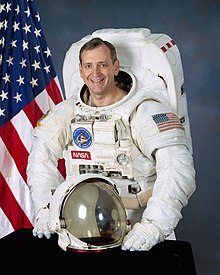Thomas D. Akers
| Thomas D. Akers | |
|---|---|
 |
|
| NASA Astronaut | |
| Nationality | American |
| Status | Retired |
| Born | Thomas D. Akers May 20, 1951 St. Louis, Missouri, U.S. |
|
Other occupation
|
Flight test engineer |
| University of Missouri-Rolla, B.S. 1973, M.S. 1975 | |
| Rank | Colonel, USAF |
|
Time in space
|
33d 22h 44m |
| Selection | 1987 NASA Group 12 |
| Missions | STS-41, STS-49, STS-61, STS-79 |
|
Mission insignia
|
|
Thomas Dale Akers (born May 20, 1951) is an American former astronaut in NASA's Space Shuttle program.
Akers was the valedictorian of his 29-member 1969 senior class from Eminence, Missouri. He worked summers as a park ranger in the 80,000 acre federal wilderness that borders Eminence. He graduated from the University of Missouri-Rolla [now the Missouri University of Science and Technology] with B.S. and M.S. degrees in Applied Mathematics in 1973 and 1975, respectively. At the age of 24 he returned to Eminence to become its high school principal. In 1979, when a United States Air Force recruiter left brochures on his desk for his students, it was Akers who decided to sign up. He was selected for the astronaut program in 1987 and officially became an astronaut in 1988.
Akers is a veteran of four shuttle flights in which he spent over 800 hours in orbit, including more than 29 hours of extra-vehicular activity (EVA) experience. In each of his flights, his role was as a mission specialist. His first space flight was in 1990 on STS-41, the 11th flight of Space Shuttle Discovery. He was instrumental in deploying the European Space Agency satellite Ulysses, a solar-exploration craft, as well as tending several secondary payloads and experiments.
His next mission was in 1992 on STS-49, the maiden flight of Shuttle Endeavour. A primary goal of that mission was to capture and repair the non-functional Intelsat VI-F3 satellite. The first two attempts failed; Akers joined the third attempt which was successful. This marks the first three-person EVA in human history and was also the longest EVA (8 hours, 29 minutes) ever conducted to that time. As of January, 2004, it is now the second longest EVA, and is still the only instance of a three-person EVA.
...
Wikipedia
